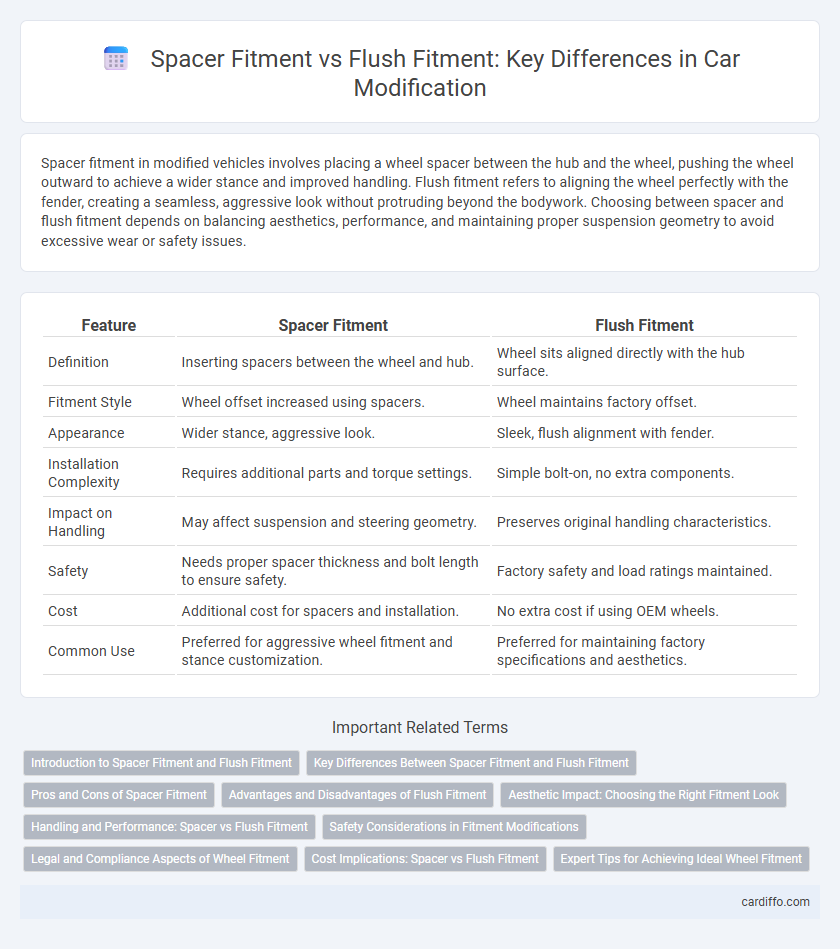Spacer fitment in modified vehicles involves placing a wheel spacer between the hub and the wheel, pushing the wheel outward to achieve a wider stance and improved handling. Flush fitment refers to aligning the wheel perfectly with the fender, creating a seamless, aggressive look without protruding beyond the bodywork. Choosing between spacer and flush fitment depends on balancing aesthetics, performance, and maintaining proper suspension geometry to avoid excessive wear or safety issues.
Table of Comparison
| Feature | Spacer Fitment | Flush Fitment |
|---|---|---|
| Definition | Inserting spacers between the wheel and hub. | Wheel sits aligned directly with the hub surface. |
| Fitment Style | Wheel offset increased using spacers. | Wheel maintains factory offset. |
| Appearance | Wider stance, aggressive look. | Sleek, flush alignment with fender. |
| Installation Complexity | Requires additional parts and torque settings. | Simple bolt-on, no extra components. |
| Impact on Handling | May affect suspension and steering geometry. | Preserves original handling characteristics. |
| Safety | Needs proper spacer thickness and bolt length to ensure safety. | Factory safety and load ratings maintained. |
| Cost | Additional cost for spacers and installation. | No extra cost if using OEM wheels. |
| Common Use | Preferred for aggressive wheel fitment and stance customization. | Preferred for maintaining factory specifications and aesthetics. |
Introduction to Spacer Fitment and Flush Fitment
Spacer fitment refers to the use of wheel spacers to increase the distance between the wheel and the vehicle hub, enhancing track width and allowing for improved handling and clearance for larger brakes. Flush fitment aims for the wheel to align precisely with the vehicle's fender, creating a clean, streamlined appearance without excessive protrusion or recess. Understanding the balance between spacer fitment and flush fitment is crucial for optimizing both aesthetic appeal and vehicle performance.
Key Differences Between Spacer Fitment and Flush Fitment
Spacer fitment involves adding wheel spacers to extend the wheel outward from the hub, increasing track width and improving stability, while flush fitment aligns the wheel perfectly with the fender for a streamlined appearance. Spacer fitment may alter suspension geometry and affect handling due to increased offset, whereas flush fitment maintains factory offset, promoting balanced tire wear and suspension performance. Key differences include impact on vehicle stance, wheel offset adjustments, and potential effects on suspension components, making each fitment suitable for different driving preferences and aesthetics.
Pros and Cons of Spacer Fitment
Spacer fitment enhances vehicle stability by increasing track width, improving cornering grip and reducing body roll. However, it can cause premature wear of wheel bearings and suspension components due to altered alignment and increased stress. Flush fitment offers a cleaner aesthetic with reduced risk to suspension health, but may sacrifice some handling benefits provided by spacers.
Advantages and Disadvantages of Flush Fitment
Flush fitment provides a sleek, factory-like appearance by aligning the wheel precisely with the fender, reducing the risk of debris accumulation between the wheel and body. It enhances aerodynamic efficiency, which can improve fuel economy and reduce wind noise during driving. However, flush fitment may limit tire size options and can increase stress on suspension components due to reduced clearance, potentially impacting ride comfort and handling.
Aesthetic Impact: Choosing the Right Fitment Look
Spacer fitment creates a more aggressive and wider stance by pushing wheels outward, enhancing visual appeal and vehicle presence. Flush fitment achieves a sleek, seamless look where wheels align closely with the fender, emphasizing precision and clean lines. Selecting between spacer and flush fitment directly influences the car's aesthetic impact by balancing boldness versus subtlety in wheel positioning.
Handling and Performance: Spacer vs Flush Fitment
Spacer fitment enhances handling by increasing track width, providing greater stability and improved cornering performance. Flush fitment optimizes aerodynamics and reduces tire wear by aligning the wheel edge precisely with the fender, promoting balanced weight distribution. Both modifications influence suspension dynamics, with spacers potentially increasing stress on wheel bearings, while flush fitment maintains factory tolerances for consistent handling response.
Safety Considerations in Fitment Modifications
Spacer fitment increases track width, potentially altering vehicle handling and load distribution, which requires precise torque settings and regular inspections to prevent wheel detachment or imbalance. Flush fitment maintains wheel alignment closer to the original manufacturer specifications, enhancing stability and reducing stress on suspension components. Ensuring correct fitment type based on vehicle parameters is critical to maintaining safety standards and preventing premature wear or failure.
Legal and Compliance Aspects of Wheel Fitment
Legal regulations for wheel fitment emphasize strict adherence to parameters such as track width, tire clearance, and wheel offset to ensure vehicle stability and road safety. Spacer fitment can alter these dimensions, potentially breaching local laws or vehicle manufacturer specifications, leading to non-compliance issues and possible fines. Flush fitment generally maintains compliance by aligning wheel edges closely with the fender, minimizing legal risks linked to improper wheel protrusion or tire rubbing.
Cost Implications: Spacer vs Flush Fitment
Spacer fitment often incurs higher long-term costs due to potential wheel alignment issues and increased tire wear, while flush fitment typically reduces maintenance expenses by promoting optimal wheel positioning. Initial expenses for spacers are usually lower than custom flush setups, but added suspension adjustments may offset upfront savings. Choosing flush fitment can enhance vehicle performance and durability, leading to cost efficiencies over time.
Expert Tips for Achieving Ideal Wheel Fitment
Expert tips for achieving ideal wheel fitment emphasize understanding the differences between spacer fitment and flush fitment to optimize vehicle stance and performance. Wheel spacers increase track width, improving handling and reducing fender clearance issues, but require precise measurements to avoid alignment problems and ensure safety. Flush fitment focuses on aligning the wheel rim perfectly with the fender edge, demanding accurate offset and wheel width calculations to achieve both aesthetic appeal and functional clearance.
spacer fitment vs flush fitment Infographic

 cardiffo.com
cardiffo.com